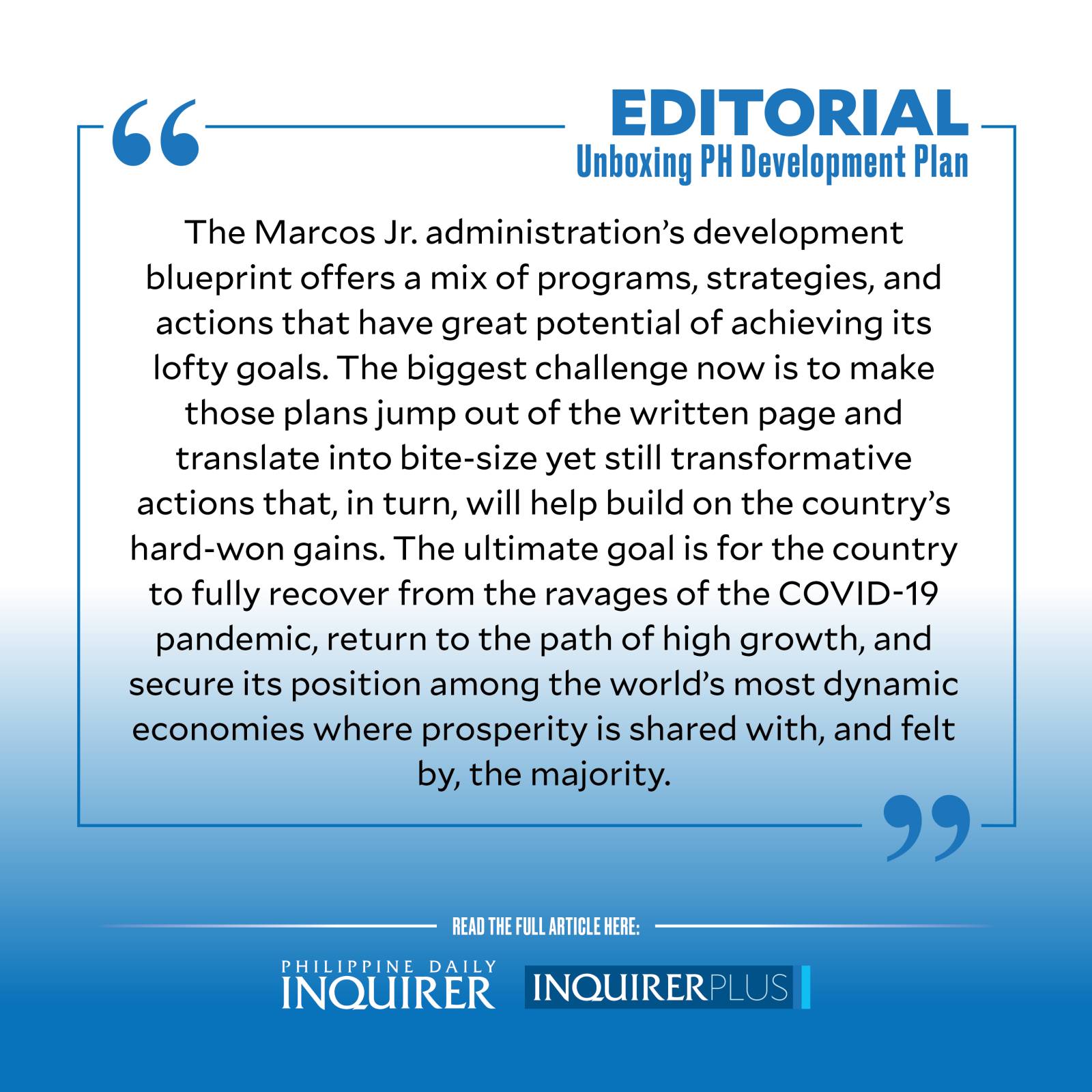Unboxing PH Development Plan
President Marcos Jr. signed this week an executive order adopting the Philippine Development Plan (PDP) to achieve by 2028 a bold and ambitious target: “reinvigorate job creation and accelerate poverty reduction by steering the Philippine economy back to its high-growth trajectory, and effect economic and social transformation for a prosperous, inclusive, and resilient society.”
That’s quite a mouthful and cynics will be quick to dismiss the PDP, which fleshes out the Marcos Jr. administration’s eight-point socioeconomic agenda, as just another one of those well-crafted plans gathering dust in a bookshelf. After all, there are no shortage of plans coming from technocrats at the National Economic and Development Authority that had translated too little into reality. The seven-month-old Marcos Jr. administration, however, said it intends to break that nasty mold to give Filipinos a “stable, comfortable, and peaceful life.”
Through Executive Order No. 14, the President last week mandated all national government agencies, state colleges and universities, and local government units to align their budget plans and programs with the comprehensive PDP blueprint. Mr. Marcos said he hopes to end his administration in 2028 with the country being better than when he found it after being elected in 2022.
Specifically, his administration seeks to employ the vaunted “whole of nation” approach to ensure that the country’s gross domestic product will grow by 6 to 7 percent this year, and between 6.5 to 8 percent from 2024 to 2028. This, while keeping unemployment levels within 4 to 5 percent, and stabilizing food prices and overall inflation between 2.5 and 4.5 percent this year, and 2 and 4 percent from 2024 to 2028. Perhaps the administration’s most ambitious goal is to reduce poverty incidence from the pandemic-caused 18.1 percent in 2021—equivalent to about 20 million Filipinos mired in poverty—to 16.2 percent this year, and further down between 8 and 9 percent by 2028.
But how exactly does the Marcos Jr. administration hope to achieve these seemingly grandiose plans?
First on the list of its “key transformation strategies” is the modernization of agriculture and agribusiness “to raise overall productivity, move Philippine products up the value chain, promote diversification, and ensure food security.” On this point alone, the government has its work cut out, given that farm output declined for the third straight year in 2022 due mainly to the drop in crop and fisheries production, particularly evident in the 2.5 percent and 6.9 percent contraction in rice and corn harvests, respectively. Clearly, drastic and immediate actions need to be taken to reverse these troubling trends and solve the string of crises in the food sector that have stoked inflation to a 14-year high, eroding the Filipinos’ already weak purchasing power.
As acting agriculture secretary, Mr. Marcos needs to be reminded—again—that he can help the country achieve its agriculture goals by appointing a full-time secretary to manage and direct this massive portfolio that affects the lives of all Filipinos. Perhaps some glimmer of hope in this field, as well as in other key sectors from services to infrastructure, is the Marcos Jr. administration’s plan to revive the public-private partnerships (PPP) model to boost its campaign to attract foreign investments. This strategy calls for increased private sector participation in massive projects where government has neither budget nor expertise to undertake on its own. The PPP worked to some extent under the Aquino III administration but was shunned in the early years of the Duterte government, before it was gingerly adopted as part of its “Build, build, build” agenda.
Putting forth a “reconfigured” PPP model is now one of the Marcos Jr. administration’s key strategies to bring about economic, social, institutional, and environmental transformation, where greater private sector participation is expected to upgrade the country’s energy, logistics, transportation, telecommunications, and water infrastructure. This is a refreshing change that must be given a chance to work, informed as it is by the successes and shortcomings seen in previous iterations so that only the best version is utilized. This means doing away with contract terms disadvantageous to the public in projects seen to contribute to the achievement of the 2023-2028 PDP.
In all, the Marcos Jr. administration’s development blueprint offers a mix of programs, strategies, and actions that have great potential of achieving its lofty goals. The biggest challenge now is to make those plans jump out of the written page and translate into bite-size yet still transformative actions that, in turn, will help build on the country’s hard-won gains. The ultimate goal is for the country to fully recover from the ravages of the COVID-19 pandemic, return to the path of high growth, and secure its position among the world’s most dynamic economies where prosperity is shared with, and felt by, the majority.





















